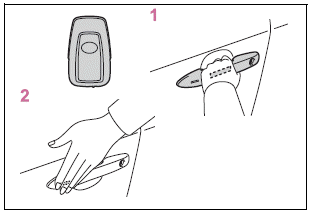Toyota Corolla: Engine compartment / Checking and adding the engine oil
With the engine at operating temperature and turned off, check the oil level on the dipstick.
■ Checking the engine oil
1 Park the vehicle on level ground. After warming up the engine and turning it off, wait more than 5 minutes for the oil to drain back into the bottom of the engine.
2 Holding a rag under the end, pull the dipstick out.
► 1.8 L 4-cylinder (2ZR-FAE) engine

► 2.0 L 4-cylinder (M20A-FKS) engine

3 Wipe the dipstick clean.
4 Reinsert the dipstick fully.
5 Holding a rag under the end, pull the dipstick out and check the oil level.

A - Low
B - Normal
C - Excessive
The shape of the dipstick may differ depending on the type of vehicle or engine.
6 Wipe the dipstick and reinsert it fully.
■ Checking the oil type and preparing the item needed
Make sure to check the oil type and prepare the items needed before adding oil.
- Engine oil selection
- Oil quantity (Low ® Full) 1.6 qt. (1.5 L, 1.3 Imp. qt.)
- Item Clean funnel
■ Adding engine oil
If the oil level is below or near the low level mark, add engine oil of the same type as that already in the engine.
► 1.8 L 4-cylinder (2ZR-FAE) engine

► 2.0 L 4-cylinder (M20A-FKS) engine

1 Remove the oil filler cap by turning it counterclockwise.
2 Add engine oil slowly, checking the dipstick.
3 Install the oil filler cap by turning it clockwise.
■ Engine oil consumption
A certain amount of engine oil will be consumed while driving. In the following situations, oil consumption may increase, and engine oil may need to be refilled in between oil maintenance intervals.
- When the engine is new, for example directly after purchasing the vehicle or after replacing the engine
- If low quality oil or oil of an inappropriate viscosity is used
- When driving at high engine speeds or with a heavy load, or when driving while accelerating or decelerating frequently
- When leaving the engine idling for a long time, or when driving frequently through heavy traffic
WARNING
■ Used engine oil
- Used engine oil contains potentially harmful contaminants which may cause skin disorders such as inflammation and skin cancer, so care should be taken to avoid prolonged and repeated contact. To remove used engine oil from your skin, wash thoroughly with soap and water.
- Dispose of used oil and filters only in a safe and acceptable manner. Do not dispose of used oil and filters in household trash, in sewers or onto the ground. Call your Toyota dealer, service station or auto parts store for information concerning recycling or disposal.
- Do not leave used engine oil within the reach of children.
NOTICE
■ To prevent serious engine damage
Check the oil level on a regular basis.
■ When replacing the engine oil
- Be careful not to spill engine oil on the vehicle components.
- Avoid overfilling, or the engine could be damaged.
- Check the oil level on the dipstick every time you refill the vehicle.
- Be sure the engine oil filler cap is properly tightened.
 Components
Components
► 1.8 L 4-cylinder (2ZR-FAE) engine
A - Washer fluid tank
B - Engine coolant reservoir
C - Fuse boxes
D - Engine oil level dipstick
E - Engine oil filler cap
F - Battery
G - Brake fluid reservoir
H - Radiator
I - Condenser
J - Electric cooling fan
► 2...
 Checking the engine coolant
Checking the engine coolant
The coolant level is satisfactory if it is between the “FULL” and “LOW” lines
(type A) or “MAX” and “MIN” lines (type B) on the reservoir when the engine is cold...
Other information:
Toyota Corolla 2019-2025 Owners Manual: For safe use
Before driving Observe the following before starting off in the vehicle to ensure safety of driving. Floor mat Use only floor mats designed specifically for vehicles of the same model and model year as your vehicle. Fix them securely in place onto the carpet...
Toyota Corolla 2019-2025 Owners Manual: USB memory
WARNING Do not operate the player’s controls or connect the USB memory while driving. NOTICE Do not leave your portable player in the car. In particular, high temperatures inside the vehicle may damage the portable player. Do not push down on or apply unnecessary pressure to the portable player while it is connected as this may damage the portable player or its terminal...
Categories
- Manuals Home
- 12th Generation Corolla Owners Manual
- Sound settings
- Lubrication system (1.8 L 4-cylinder [2ZR-FAE] engine)
- Changing settings of the pre-collision system
- New on site
- Most important about car
Unlocking and locking the doors from the outside
■ Smart key system (if equipped)
Carry the electronic key to enable this function.

1 Grip the driver’s door handle to unlock the door. Holding the driver’s door handle for approximately 2 seconds unlocks all the doors. Grip the front passenger’s door handle to unlock all the doors.*
